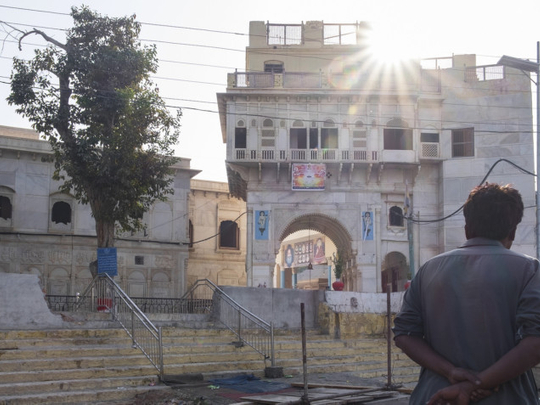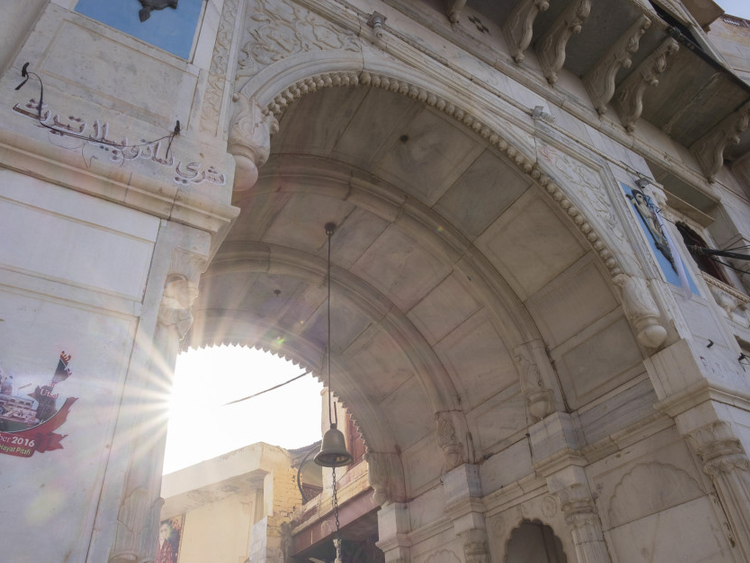
Dubai: In the middle of the Indus River lies a small, tear-shaped island called Sadhu Bela – the woods of the sage.
On the island is a door, and engraved on its white marble façade, these words:
“If I had a palace made of pearls, inlaid with jewels, scented with musk, saffron and sandalwood, a sheer delight to behold – seeing this, I might go astray and forget You, and Your Name would not enter into my mind.”
The door opens to Dharam Mandir, just one part of a sprawling temple complex spread over nine acres, sacred to both Hindus and Sikhs, and a heritage site in Sindh, Pakistan.
There still exists a tree in the temple premises under which, Guru Nanak, the founder of Sikhism, taught sadhus about the path of life.
Gulf News reader Faraz Waqar visited Sadhu Bela and said he was amazed by the beautiful temple isle: “Sindh, even today, has some of the highest numbers of Hindus in Pakistan and has always had a syncretic Indo-Hindu-Islamic culture, where people from all faiths have coexisted for centuries and lived in cultural harmony.”
While Hindus and Sikhs, even those from across the border in India, visit the temple complex, its care and control is in the hands of Pakistan’s Waqf Board. In 2013, the Board supervised major renovations and repairs of the temples and shrines, at a cost of Rs487 million (Dh16 million).
It is not unusual to see people from different faiths taking care of each other’s sacred monuments. A 79-year-old Hindu man has been the caretaker of the century-old Budh Wali Masjid in Uttar Pradesh, India, for decades. The key to one of Christianity’s holiest sites – the Church of the Holy Sepulchre in Jerusalem – has been under the care of a Muslim family for generations.
It’s a story of tolerance and coexistence that has bridged hearts around the world, time and time again.
Pakistan’s Sindh region knows this well. Waqar said: “The famous Mughal emperor Akbar, who is renowned in world history for his policies of religious tolerance and bringing various cultural and religious groups of the Subcontinent together under the banner of the Mughal Empire, was born in Sindh.”
It is during the time of the Mughal reign that the story of Sadhu Bela begins.
Baba Bankhandi Maharaj, a 15-year-old spiritual seeker, whose origins were reportedly either from Kero Khetar near Delhi, or Nepal, arrived in Sindh in 1823, in the town of Sukkur, which was then a major trading hub for the Subcontinent. He settled in the forested island of Menak Parbat (which is Sadhu Bela’s original name), alone, and became known as the sage of the woods, living there till he died at age 60.
Soon, news began to spread about the unusual young monk. Holy men and spiritual people of other faiths began to join him on the island.
Over a period of 300 years, the forested land gave way to a spreading complex of temples, dedicated to different deities. Waqar said: “A unique feature is that many prayers and texts are written here in Sindhi, the language of the Sindh province in Pakistan – its lettering resembles the Arabic script.”
Today, the island is famous for Teerath Asthan, Pakistan’s biggest temple. The complex has eight other temples, a library, dining areas, a huge garden, along with rooms and residences for monks and people who want to stay on the island on a spiritual retreat. The tiny island regularly draws in seekers from different faiths, and neighbours from across the border.
Waqar said: “There is a major Diwali fair held on the island every year and people following the Hindu faith gather from all over Pakistan, and India, to visit it. The ‘gaddi nasheen’ of the temple (the family that has been managing the temple complex for generations) moved to India after Partition in 1947. But members of the family still travel once a year to Pakistan to officially open and attend the fair, as symbolic keepers of the temple complex.”
The island is cocooned in harmony, with Hindu and Sikh worshippers, Muslim caretakers and gaddi nasheen who remember the words on the simple, white-marbled door, centuries after it was inscribed: “...I might go astray and forget You, and Your Name would not enter into my mind.”















